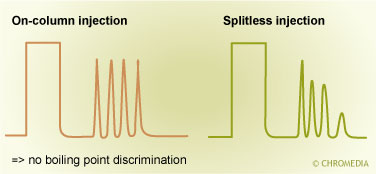Cold on-column injection
- Page ID
- 61177
Cold on-column injection offers excellent quantitative results with capillary columns.
Feature on-column injector:
Critical Parameters on-Column injection:
Contrary to other injection modes, the liquid sample does not need to be vaporised but is directly injected as a liquid from the syringe onto the (cool) column. This way discrimination due to evaporation processes in the injector are avoided.
On-column injectors do not need liners and, therefore, their designs differ significantly from other injectors. Since the needle of the syringe is introduced into the column, the needle must be extremely thin in view of the small internal diameters of capillary columns. As there are no finer needles than 0.2 mm external diameter, on-column injections is often used in combination with a wide-bore (pre) column.
Each on-column injector is therefore equipped with some type of seal, either a metal slider that can be opened or closed or a flexible seal (polymer material).
Injection criteria
The fact that the sample is introduced directly onto the column involves several important requirements:
- Sample concentration
The sample capacity for capillary columns is limited and this fact is not altered by the injection mode used.
On-column injection introduces the entire sample from the syringe into the column. This means that samples introduced via on-column injection should be far more dilute than with split injection, otherwise severe overloading will occur.
On-column injection is excellent for trace analysis, where the low levels of concentration, coupled with the amounts of sample that can be applied, yield enough loading of the column to produce acceptable peaks. - Injector temperature
The injector temperature must be sufficient low at the time of injection to avoid any premature vaporization of sample components, particularly the solvent, otherwise there will be some peak distortion and tailing effects. - Column temperature
The process in the column is comparable to that during splitless injection. There is also a 'solvent effect' because the sample will remain liquid during the injection. The column temperature should be well below the boiling point of the lowest boiling sample components. The moment the injection volume is introduced onto the column, the chromatographic process can begin by starting the temperature program. - Stationary phase
On-column injection is only possible in combination with a chemically bonded phase or by using a retention gap. - Choice of solvent
Two points of view are important in the choice of solvent.- The boiling point of the solvent must be lower than that of any of the sample components. If the difference in boiling points between solvent and sample components is large (more than 100oC) no problems can be expected. The chromatographic process during the temperature program will be normal.
- If the difference in boiling point is small (between 0 and 20oC) co-elution may be observed. The solvent effect takes place when the difference in boiling points is between 20 - 80oC. Components, which profit from the solvent effect, produce very narrow chromatographic peaks. During the time the solvent is present as a liquid in the column, it acts as a stationary phase, and components will be re-concentrated.
The solvent effect is not only dependent on the differences in boiling point, but also on interaction possibilities (caused by e.g. polarity of both solvents as well as components).
On-column versus splitless injection


